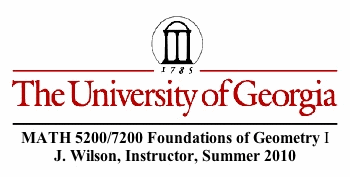

Problem Set 1.3
37 Problems
1. Which part of the following statement requires the use of the Parallel Postulate and which does not?
Two lines cut by a transversal are parallel if and only if a pair of corresponding angles is congruent.
Solution:
It may be useful to be explicit about the "parts" of the statement:
A. If two lines cut by a transversal are parallel then a pair of corresponding angles is congruent.
B. If two lines cut by a transversal have a pair of corresponding angles congruent, then they are parallel.
Statement A is Theorem 1.18 and was proved by developing a contradiction with the parallel postulate.
Statement B is Theorem 1.17 and was proved before introducting the parallel postulate.
2. This problem was solved in Now Solve This 1.4.
3.
4.
5.
6. Write-up by Patty Wagner See GSP file. I could not easily format this into an HTML document.
7.
8.
9.
10.
----------------------
---------------------------
---------------------------
12.
13.
14.
15.
17. Give an alternative proof of the fact that any two medians divide each other in the ratio of 2:1 by proving first that if P and Q are the midpoints of segments BO and CO, respectively, then MNQP is a parallelogram.
Proof:
By the Midsegment Theorem
in triangle BOC, PQ is parallel to BC and half its length.
in triangle ABC, MN is parallel to BC and half its length
By Thm 1.27, part 4, if in a quadrilateral one pair of sides is parallel and congruent, then the quadrilateral is a parallelogram. Therefore MNQP is a parallelogram.
As a parallelogram, the diagonals MQ and PN bisect each other. So MO = OQ, but OQ = QC. Therefore OC = 2MN so the ratio OC:MO = 2:1.
Likewise, we have OB:NO = 2:1.
18.
19.
20. Comment: In this problem, a proof is given to prove that PQ is one-half the difference of a and b. The question asks, "What is missing in this proof?" Implied is the question "Can the proof be completed by adding additional reasoning?"
Comment: Can the colinearity of P, Q, and S be established? Assume there is a triangle PQS (i.e. P, Q, and S are not colinear) . Can that lead to a contradiction?
21.
Write-up Adapted from David Andrews

Click HERE for a GSP file. Or create your own GSP File.
Conjecture: a) The quadrilateral with internal bisectors is a square. b) The quadrilateral for bisectors of the external angles is a square.
See the GSP file for one proof. Be sure to examine all three pages of the GSP file.
23.
24.
25.
26. Prove the converse of the Midsegment Theorem for triangles: If a segment MN connects two points on sides of a triangle, is parallel to the third side and half its length, the M and N are midpoints of the sides.
27.
28.
29.
30.
Another Suggestion by Stephanie Britt
NOTE: We need to avoid explict or implicit use of similarity to argue for the congruence or equal measures of angles. For example, in the suggestion on the right just above, observing that triangle with dashed lines for two of its sides is isosceles tells us that the two base angles are equal and we can see readily that the base angle at the right has measure of x + y. Now considering that the right triangle with measure y for one of its acute angles has legs of 2 units on one side and one unit on the other side, the acute angles are complimentary. The construction shows angles congruent to these two complimentary angles on either side of the angle formed by the dashed lines. Therefore the dashed lines have a measure of 90 degrees and any argument using similarity can be avoided.
Stephanie's suggestion can also be followed through without argument using similarity.
-----------------------------------------------------------
NOTE: Similarity is used here in using the different unit size of the squares to get the blue triangle with angle size a and argue that it has the same angle measure as the one with angle measure x.
32. Consider an equilateral triangle. For a point P inside the triangle, make a conjecture about the sum of the distances to the three sides from that point. Prove your conjecture. Does the conjecture hold for point P on the triangle.
Conjecture to be proved: The sum of the distances to the three sides of an equilateral triangle from any intermal point P is equal to the length of the altitude.
33.
34.
35.
37.